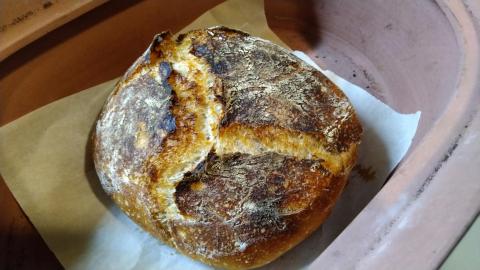
Strong levain and cassava flour sourdough

I came home to see that my levain was doing quite well in my Doraemon bowl! The CO2 got trapped by the cling wrap. Interesting.
I mixed some unusual cassava flour this time. Cassava flour is gluten free stuff and this one was not toasted. I would like to try the toasted one sometime later on. The cassava flour needs to be hydrated before mixing. Since it was the first time I used, I hydrated with boiling water, but I think tap water would work just as fine.
I did not keep a good track of all ingredients, but here it goes:
80 g levain at 100% hydration
25 g cassava flour at 200% hydration
170 g flour (12% protein)
30 g semolina
80 g WW
4.5 g salt
177 g water
Total flour: 350 g
Total water: 267 g
I have done the standard procedure that I have followed lately: (1) Dissolve levain in water as well the cassava blob. It was a little gummy after hydrating, so I had to dissolve it by hands. (2) Add all flour and mix into a shaggy mass. (3) Wait for 30 min and add salt, kneading for 30 sec to 1 min. (4) Apply 3 sets of stretches and folds every 20-30 min. (4) Bulk fermentation needs to be about 4 hours. (5) Shape and retard in the fridge for about 6 hours. (6) Bake straight from the fridge on a 230 C deg oven for 45 min with lid on + 10 min with lid off (I started baking on a cold pot). (6) Wait to cool and slice
Crust and crumb were quite good. Since the cassava flour is mild in taste I could not identify it in the final loaf. Note that cassava flour and tapioca starch are different things. The cassava flour is not fermented, so the flavor is mild. Since I scalded the cassava in boiling water, it felt as the tangzhong method. Being gluten free, cassava flour is becoming a good option for those with celeriac decease. You will find other names for the product including: cassava, manioc, mandioca, yuca, ...).





Comments
Very lovely bread and creative too! Those little beasties just love carbohydrates no mater what the gluten content. They are telling you they're happy! Had this happen in my favourite big coffee mug. Nice and cozy they are.
Have you tried making a starter feeding fermented cassava root? I bet it would work. If I knew what I know now, 27 years ago I would not only be a little snockered with the fishing village women, but baking sourdough as well. Lol!
I'm betting the reason for the scald is not only to hydrate but to prevent invading fungi from the soil. Hydrating with a scald will make a difference. Wonder if adding more water to the cassava flour would prevent it from balling up. Like 5 to 1, boiling water to flour. Just shift the recipe water around a little bit.
:)
Thanks Mini,
I never tried making a starter using fermented cassava flour, but I think it may work. In fact, it was the first time I mixed it in the dough. Yes, some indigenous people use cassava to make alcoholic spirits.
The flour I used is not toasted, so it has been only dried during the production process, so hot water may help further sterilize. I will try shifting more water onto the hydration stage and see what happens.
https://en.m.wikipedia.org/wiki/Tapai
Near the bottom of the page are directions. I wouldn't mix with cinnamon or garlic or cloves as these have antibacterial properties and hinder starter development. There are Javanese selling stalls pictured and they bring back memories! I can almost smell them. The village ladies would cut up one root into tiny little pieces and distribute to be mixed with watery cooked rice to ferment for several days. Sort of like their version of friendship starter and my first introduction came wrapped in banana leaf. Banana leaf may also contribute to some interesting flavours in bread, worth exploring!
The loaf looks lovely! I think you are right about it acting as a tangzhong method. Beautiful, shiny and custardy looking crumb!
Cassava is an interesting food. If it isn't processed properly before consumption it can actually make you very sick or even kill you as it contains very high levels of cyanide. The processing (by various methods-soaking,boiling, drying,fermenting,frying) actually allows the cyanide to be extracted or dissipated in different manners. With such foods as cassava that are actually staples in many parts of the world for centuries, it begs the question , "How did the early peoples figure out how to process the cassava root so it didn't kill them?" I am guessing that "Necessity is the Mother of Invention" and when starvation is looming, a lot of fringe ingredients look delicious.
https://en.wikipedia.org/wiki/Cassava
Lovely bread!
Scroll down to FOOD USE/Potential Toxicity, and Food Preparation.
Mother Nature provides some interesting challenges!
Thanks Clazar for the comments.
Interesting article on cassava. I have been eating cassava since I was a kid. I remember feeding fresh leaves to live stock (pigs love them). The cassava varieties we eat are proper for consumption. My mom used to cook the tubers after peeling the skin off and soaking in water for some time. The tubers could be eaten right after cooked in water. For something more crispy and tasty, deep-fry them after cooked. Even the leaves of the wild varieties can be eaten if properly processed, and are common in the north part of Brazil, where you can find endemic varieties of cassave (maniçoba and tacacá dishes). They are all delicious and very unique.